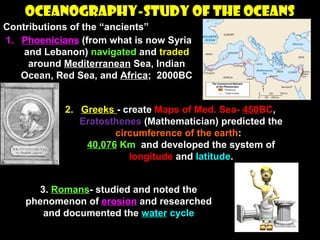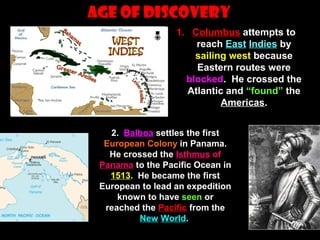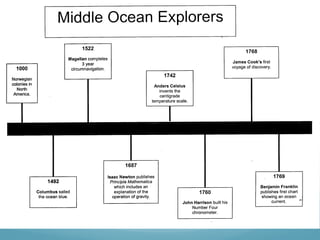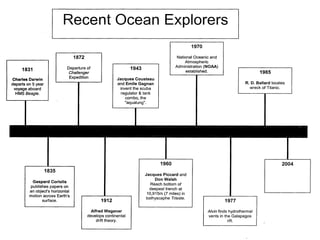3 history of oceanography
- 2. OCEANOGRAPHY-Study of the Oceans Contributions of the “ancients” 1. Phoenicians (from what is now Syria and Lebanon) navigated and traded around Mediterranean Sea, Indian Ocean, Red Sea, and Africa; 2000BC 2. Greeks - create Maps of Med. Sea- 450BC, Eratosthenes (Mathematician) predicted the circumference of the earth: 40,076 Km and developed the system of longitude and latitude. 3. Romans- studied and noted the phenomenon of erosion and researched and documented the water cycle
- 3. story of Ocean Exploration 3 min tory of Oceanography 3 min
- 4. Middle Ages 1. Fall of the Roman Empire -Europe lost most of its detailed understanding of geography 2. During this time, Arabic nations continued to explore and expand trade routes…. 3. The Vikings were ship- borne warriors and traders of the north (Norsemen) who went on expeditions to explore the Americas, Iceland, Greenland
- 5. Age of Discovery 1. Columbus attempts to reach East Indies by sailing west because Eastern routes were blocked. He crossed the Atlantic and “found” the Americas. 2. Balboa settles the first European Colony in Panama. He crossed the Isthmus of Panama to the Pacific Ocean in 1513. He became the first European to lead an expedition known to have seen or reached the Pacific from the New World.
- 6. Age of Discovery 3. Magellan was credited with being the first around the world… though while on voyage, he was killed in the Philippines in 1521. However, the 18 members left of his Crew finished the voyage in 1522. The “sea” becomes a new place for empires to interact. It was the Era of trade with, and plunder of, the Aztecs and Incas for their gold and silver by the Spanish. The English and the Dutch pirates attack the Spanish fleets.
- 7. MORE discoveries…. 1. Captain James Cook- 1700’s A British navigator who discovered the Hawaiian Islands. Is considered the best cartographer and reckless navigator of his time. Applied use of latitude and longitude. 2. Ben Franklin 3. Charles Darwin- charted maps of the 1800’s sailed to gulf stream in 1777. the Galapagos Islands to study the Biology of the Sea and in the process developed his Theory of Natural Selection.
- 8. 4. Edward Forbes -1800’s predicted different types of plant and animal life at different depths of the ocean. Introduced the idea of dredging. 5. Challenger Expedition- England’s Royal Society obtained the use of HMS Challenger to study sea floor characteristics, chemical composition of sea water and life at all levels! 6. Fridtjof Nansen- 1890’s Proved polar ice flowed. Entered ice by Alaska, exited by Greenland three years and over 1000 miles later. Determined that the North Pole is landless
- 9. 20th Century Oceanography 1. German expedition- 1920’s ship named Meteor was used to map depths in the Pacific Ocean. 2. US National Ocean Survey- Today data is generated from an Bathymetric readings to determine echosounder (sonar) mounted how deep each ocean is. Early beneath or over the side of a boat, techniques used pre-measured "pinging" a beam of sound heavy rope or cable lowered over a downward at the seafloor. ship's side. 3. National Oceanic and Atmospheric Administration (NOAA) establishes wise use of ocean resources, minerals, oil, fish, etc…
- 10. Sonar 3 min
- 11. 20th Century Oceanography 4. Oceanographic studies EXPAND!! Scripps Institution of Oceanography develop FLIP (Floating Instrument Platform) boat that turns vertically for research at different depths When FLIP is in its vertical position it is both extremely stable and quiet. It is used to study the way water circulates, how storm waves are formed, how heat is exchanged between the ocean and the atmosphere, and the sound made by underwater marine animals.
- 12. 5. Submersibles- ALVIN Created by Woods Hole Oceanographic Institution and can carry up to 3 passengers to great depths (14,764 ft.), explore the ocean, the organisms there and record data. 6. Jacques Cousteau- SCUBA; Declared the importance of the oceans, he was a champion of the life that existed there and saw pollution—and exploitation by man--as the destroyer of the marine environment.
- 13. Submersibles 2 min Submersibles 2 min
- 14. ating a timeline of Historical Events in Oceanogra First attempt at a bathymetric map by Matthew Fontaine Maury. Showed vast relatively shoal area in Mid-Atlantic Grave. Source: In The Physical Geography of the Sea (1855) by M. F. Maury .
- 18. Important People of Oceanography •For each person, write important facts and accomplishments. •Draw a picture that relates to that individual. • Ballard, Robert • Cook, James • Cousteau, Jacques • Darwin, Charles • Franklin, Benjamin • Magellan, Ferdinand • Piccard, Jacques • Wegener, Alfred


















